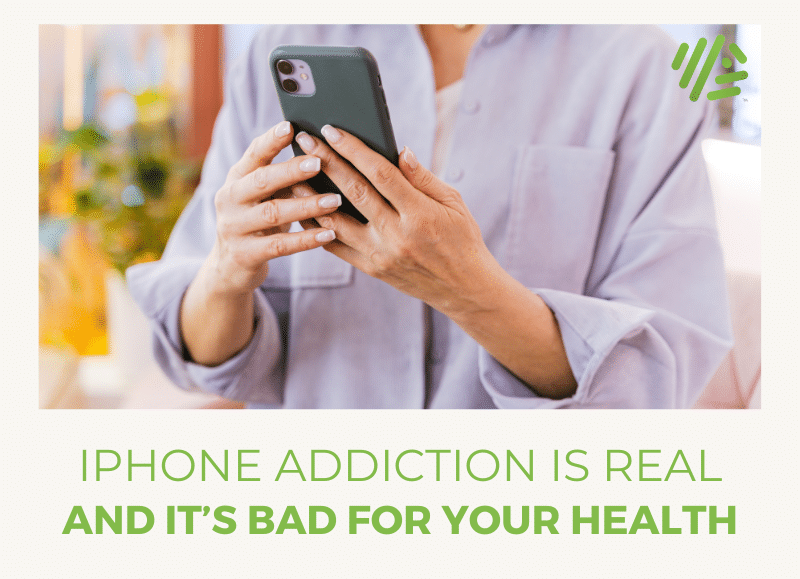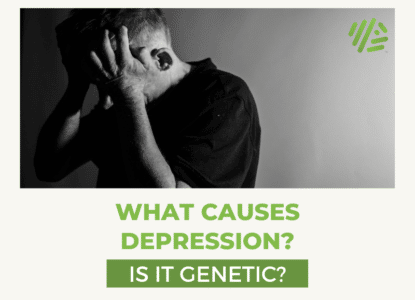iPhone Addiction is Real and it’s Bad for Your Health

Contents
A few years ago now, an episode of 60 minutes documented just how anxious people become when they’re separated from their phones. In one experiment, Anderson Cooper’s cortisol levels spiked when his phone vibrated a few feet away and he couldn’t check it. More recently, The Social Dilemma, a Netflix documentary, highlighted the same problem of technology addiction.
Maybe you can relate?
I know I can.
Most of us are addicted to our smart phones, but we laugh it off like it’s a non-issue.
It’s not.
Compulsive phone use is a real problem, with potential health consequences. Addiction to drugs and alcohol is established science, with a massive rehabilitation industry devoted to helping people recover, but not for mobile devices, right?
Not necessarily.
Let’s consult Merriam Webster dictionary for a working definition of what it means to be addicted:
compulsive need for and use of a habit-forming substance (such as heroin, nicotine, or alcohol) characterized by tolerance and by well-defined physiological symptoms upon withdrawal; broadly :persistent compulsive use of a substance known by the user to be harmful
Take out the word “substance” and swap “device,” and boy, oh boy, does the shoe fit.
Most of us check some type of device compulsively every few minutes, or in some cases, every few seconds.
The result?
Response time expectations in social groups are out of control. Attention spans are gone. Withdrawal symptoms are easily documented, and not after days, but immediately after we are separated from our phones.
Our technology causes stress
But it’s not just separation that causes anxiety as the 60 Minutes story suggested, it’s using the phone itself.
Our phones are sources of stress and stress, in turn, damages our wellbeing. According to The National Institute of Mental Health, chronic stress can contribute to the following conditions:
- immune,
- digestive,
- cardiovascular,
- sleep,
- and reproductive systems
We’re constantly invited into a beeping app, new email, or text message. The overwhelming majority of the notifications are nonevents, the opposite of urgent. And yet, we are forced to live in a state of constant vigilance, never knowing what lies around the digital corner. Always stressed.
This is no way to live.
And it hasn’t been the way we’ve lived, until very recently.
The iPhone phenomenon is new, and we don’t know the long term effects.
And I will delve into the possible health impact in a moment, but first, an anticipatory rebuttal.
But, we “need” our phones, right?
In theory, we “need” our phones to conduct business, to occasionally hail an Uber, or to be available for a loved one in an emergency.
But how often do we use the phone for these tasks?
Rarely, if ever.
The normal scenario is mindless scrolling through half read articles and Instagram photos.
Point is, most of the content is crap.
No one reads anymore
It’s crap and we don’t even consume it. We glance at it and move on to the next thing. We don’t actually read what we “look up,” we’re not really friends with our online “friends.” We skim, and we scroll, back and forth like a ping pong ball. Instagram to Facebook, back to Twitter, now on the News. None of it digested, none of it internalized.
Facebook is toxic enough on desktop, why would you need it on your phone?
Phones are designed to be addictive
Because it’s all designed to be addictive.
You’re not looking at your phone from early morning to late at night by accident, it’s by design. Tech companies design apps and interfaces to hook users so they can sell collect your personal information and sell it to advertisers.
And this isn’t all just O’Connor bluster. I am going to step down off the soap box for a moment and let a scientist take over.
The science of iPhone addiction
Passing the mic to Aaron to explain the science behind smart phone addiction.
Addiction is driven by positive feelings. You try something once and it feels good, so you try it again, and again until you’re hooked looking for that reward.
These positive feelings are generated in the brain with the neurotransmitter dopamine, which is used by the mesolimbic pathway, more commonly known as the reward pathway.
To keep it simple, particular activities trigger the release of dopamine. In turn, this stimulates a region of the brain known as the nucleus accumbens, which regulates desire, motivation and the feeling of reward.
Extensive stimulation of this pathway can lead to alterations in the brain linking that reward feeling with desire and motivation.
The strength and duration of dopamine release has a major impact on the changes in the brain, which is why drugs such as cocaine and methamphetamine can become so addictive as they significantly increase dopamine levels in the brain. It’s difficult to investigate these effects in people due to the ethical issues surrounding introducing potentially addictive substances to people. However, a significant amount of work has been performed in animal models, whereby depletion of dopamine from the animal brain significantly reduced addictive behavior, but adding dopamine stimulating drugs significantly increased addictive behavior (R,R).
See also: AKT1 gene – the Weed Gene
Your phone and dopamine
So you can see that dopamine plays a major role in addiction, but how does this tie in with your phone?
Well that user interface, those app interactions and the gamification present in many apps is specifically set up to promote dopamine release. An app you use once is not really of benefit to the developer unless you paid a hefty fee for it… how often do you do that? But free, or cheap apps? There are loads of those, and it’s in the developers best interest to keep you engaged with their app, to increase the chances of you making a purchase, or providing information that can be sold to advertisers. This all leads back to the increase in cell-phone addiction (R).
So from animal models, we know that an increased level of dopamine in the brain can increase addictive behaviors, which can also be seen in the brain of addicts (R). Surprisingly for some, use of a smart phone also stimulates dopamine release, and in many people, addiction.
6 ways smart phones damage health
#1 – They’re dirty
Really dirty. In fact, 10 times dirtier than a toilet seat, and yet you eat every meal with a smartphone in hand.
Disgusting.
See also: We tested our phone for germs and it went worse than we thought.
#2 – They emit potentially harmful radiation
This is not in dispute. Cell phones emit radiation. The question is whether that radiation leads to bad health outcomes. Time will tell.
I wear a headset or use speaker phone whenever I am talking on my phone. Am I being overly cautious?
Probably not.
The National Cancer Institute has an entire page devoted to cell phone use and cancer risk, and while they say that radiofrequency energy of the type emitted by cell phones does not cause cancer:
Radiofrequency energy, unlike ionizing radiation, does not cause DNA damage that can lead to cancer. Its only consistently observed biological effect in humans is tissue heating.
They concede later on that there are studies which show a correlation between cell phone use and brain cancer:
These studies have not shown clear evidence of a relationship between cell phone use and cancer. However, researchers have reported some statistically significant associations for certain subgroups of people.
Cancer data is not conclusive, but that doesn’t mean cell phones don’t cause health problems in people.
#3 Cell phone use can lower sperm count
In the 4 Hour Body, Tim Ferriss discusses how carrying his cell phone in his front pocket everywhere caused his sperm to take a major hit. According to Ferriss, when he stopped carrying his phone in his front pocket, his sperm returned to normal. Turns out there is science to back him up.
The electromagnetic waves emitted by cell phones have indeed been shown to damage sperm.
#4 – Smart phone use can cause anxiety and depression
This study out of the University of Illinois found that heavy phone usage was linked to anxiety and depression in some college students, and this discussion about cortisol levels and smart phone use with Dr. Nancy Cheever at California State is intriguing, but do we really need a study to state the obvious?
When you stop to think about it, does it feel good to endlessly scroll through meaningless content on your phone? Does compulsively checking a device make you happy?
I can only speak for myself, but I don’t feel my best when I’m going down an Instagram rabbit hole.
The real issue here is that compulsive use of a cell phone increases stress levels in many people, and chronic stress is a big contributing factor in many diseases, including the digestive ailments that are becoming so common these days.
#5 Phone use disrupts sleep
The blue light from your phone throws off your circadian rhythm, making your body think it’s time to wake up, when it’s actually time top hit the sack. This video from the American Chemical Society does a nice job ox explaining how this works. Excessive use of technology is one cause of poor sleep.
#6 Constantly checking your phone kills attention span
Thanks to the constant drumbeat of technology driven distraction, some studies estimate that the average human attention span has sunk below that of goldfish. (R) Phone addiction has made it virtually impossible to achieve anything resembling deep work, the state required to master a subject, or to just write a blog post (yes, I have about 9 other tabs open in Chrome as I write this).
It has been estimated to take about 25 minutes for the average person to get back on task after an interruption. In light of the burden task switching and lack of focus places on productivity, what is the cost academic, or professional cost associated with a phone addiction?
Each person is different, so it is impossible to know for sure, but I have had conversations with close friends recently where we seriously wondered whether we’d be able to produce our best work product, or the best version of ourselves for that matter, tied to the phone like we’ve been. If your goal is to produce good work, or even to truly learn something, rather than just aimlessly skimming, can you achieve these tasks and regularly use a smart phone?
I have my doubts.
Is intermittent digital fasting the solution?
Ok, so we’ve painted a pretty bleak picture here. Tech companies have designed phones and apps to be addictive, and as a result, we’re all now on the Silicon Valley dopamine train.
Is there a stop? Can we break free of our digital chains?
I’m not so sure “we” can. As Russ Douthat at the NY Times has pointed out, social media and smart phones have become the “opioid for the masses,” and it’s likely to stay that way.
Or get worse.
However, one practice I’ve found to be somewhat useful in stemming the mind numbing tide of beeps, dings and apps is intermittent digital fasting. Of course, many of you have heard of intermittent fasting, the practice of eating in 8 hour windows so the body has the chance to cycle through much of its stored glucose and glycogen and begin the process of burning fat for energy, but that’s not what I am talking about here.
With intermittent digital fasting, we block out times when we commit to not using technology. Technology use doesn’t necessarily need to be limited to an 8 hour window, but it’s imperative that significant periods of time throughout the day are technology free, and that you have a hard stop at some point in the evening.
For example, by turning off data on my iPhone, and only using the device when I have a Wifi signal, I prevent myself from mindless browsing when I’m at dinner, or in my car. It’s a very useful technique, and one that reinforces that the “phone” is not a phone, it’s a mini computer. Leaving the house sometimes with just a flip phone (be prepared for burner jokes) is ok. You’ll survive.
The point is be mindful of the fact that when you use your phone compulsively, you’re not acting freely. You’re acting like an addict, and there are board rooms full of people who want you to use their product in the exact, excessive way you currently do so they can sell your information to a company who can sell you more stuff.
Once you realize that tech isn’t very different from tobacco, a new paradigm emerges.
The first step to recovery is admitting you have a problem.




regardless of the effects on people, it is imperative to look at how it began 20 years ago. at least where i live, it was about 2003 that all of a sudden driving with a cell was aloud, and from day one i saw how people weren’t paying attention while walking and so forth. the police have been trying to stop people driving with them and can’t, so obviously that wasn’t taken into account from the start. people’s obsessions more or less transferred from the T.V. mainly to phones–this technology crisis didn’t begin just yesterday, and there have been people ignored who warned of the ramifications. now you have people that consider getting in an accident normal because of phones; that is more madness.